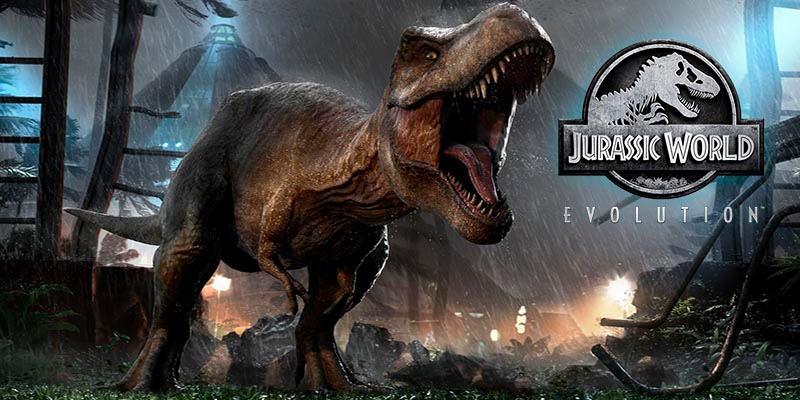
Considering the franchise is about a dinosaur zoo, you’d think that the theme park management genre would be the most logical place to start when making a new Jurassic Park game. Unfortunately, the reality is that the last park management game based on the license was 2003’s Jurassic Park: Operation Genesis, and while it was a great game, we could do with something a bit more modern. There were two Jurassic Park builders on mobile, but I don’t count those since they are glorified clickers where the most efficient way to expand your park is mom’s credit card. So, as a fan of the franchise and all things involving dinosaurs, I was pretty excited when it was announced that the developers behind Planet Coaster were making a park management game based on the recent Jurassic World films. Sadly, the end result leaves much to be desired.
Jurassic World Evolution
Publisher: Frontier Developments
Developer: Frontier Developments
Platform: PC (reviewed), Xbox One, PlayStation 4
Release Date: June 12th, 2018
Players: 1
Price: $54.99 (standard version), $59.99 (digital deluxe edition)
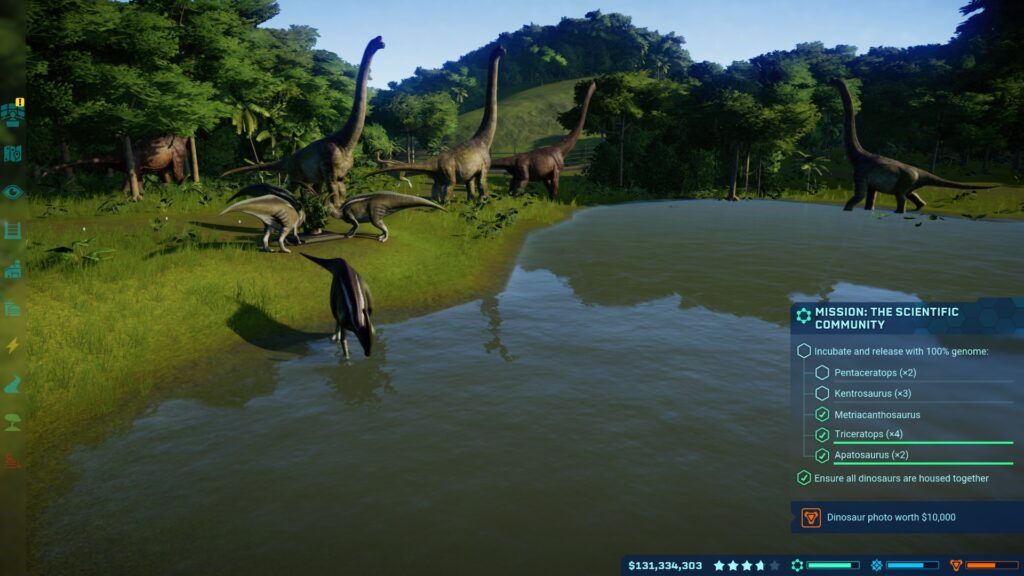
Jurassic World Evolution places you in the shoes of a freshly appointed chief-of-operations overlooking the Muertes Archipelago, the infamous six islands off the coast of Costa Rica that Masrani Corp and InGen use as both a network of theme parks, and a proving ground for their genetically-engineered experiments. Five of the islands serve as a mixture of campaign and tutorial, with Isla Nublar being the location of the game’s sandbox mode.
You will travel across the five other islands over the course of the campaign, completing missions and earning favor with the theme park’s three factions to unlock new buildings, upgrades, and dinosaurs. These factions include the Science, Entertainment, and Security Divisions. Each island will have one big, multipart story mission to complete for each faction, and they’ll also periodically offer generic, randomly generated side contracts to gain some extra favor and money. The ultimate goal of the five campaign islands is to complete the three main missions, earn enough favor with each faction to unlock all the rewards they offer, and optionally, achieve a 5-star rating for your park.
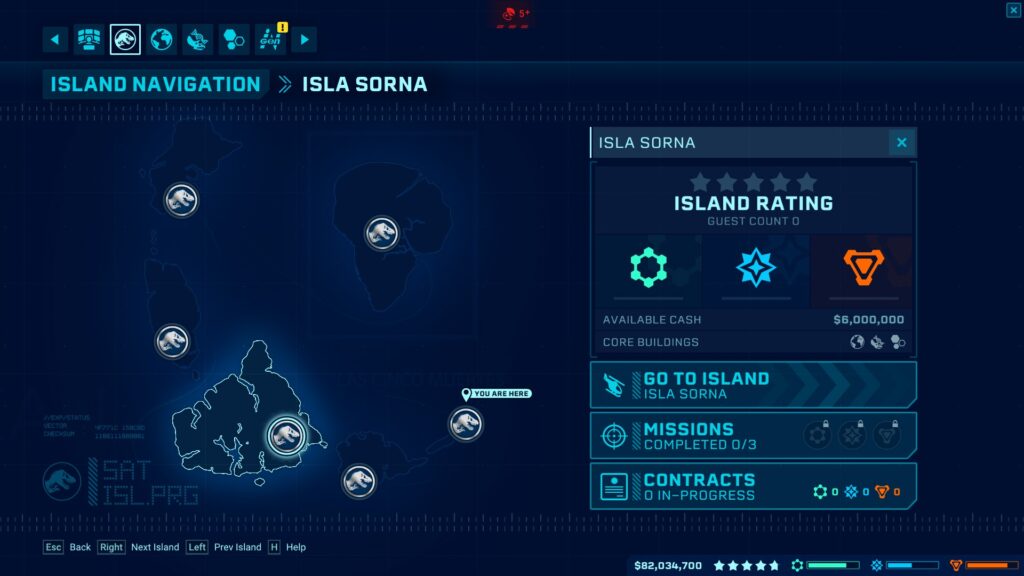
While the first island is straightforward and uncomplicated, the other four all have challenges that generally revolve around specific game mechanics. Isla Pena, for example, is a small and remote island that will require you to min-max enclosure sizes and focus on big ticket attractions, while Isla Sorna has wild dinosaurs roaming around the island.
The story features characters both new and old, including Dr. Ian Malcom, who is voiced by Jeff Goldblum himself. His acting and lines are mostly decent enough, but you can definitely tell he was just in it for the paycheck. Other characters from Jurassic World appear too, such as Claire, Owen, and the nefarious Dr. Wu, but most the characters you’ll be hearing from were made specifically for the game. Ultimately though, you won’t be playing this game for its story and voice cast.
The missions for each faction generally revolve around completing specific objectives to further that faction’s goals. The Science Division missions usually involve gene splicing and studying certain species of dinosaurs to see how they interact with each other, while the Entertainment Division is focused on building flashy attractions to pull in larger crowds. These two factions have fairly logical missions overall that make sense based on what you’d expect from scientists interested in studying dinosaurs, and a marketing firm trying to maximize profits.
The Security Division, however, are the cartoonishly evil oddballs. These guys seem to believe that the parks are their own personal dinosaur fight club and recruitment ground for prehistoric super soldiers. Yes, they reuse the weaponized dinosaurs plot from the two Jurassic World movies. To give you an idea of how outlandish their main missions are, the first one literally involves intentionally releasing a dinosaur to test the island’s emergency response systems. No, I’m not joking. The second one involves genetically enhancing a velociraptor and a dilophosaurus, putting them in an enclosed area, and allowing them to fight to the death to see which is stronger. I know that the last two movies had the whole “military bad” subplot, but this is kind of stretching the limits of believability.
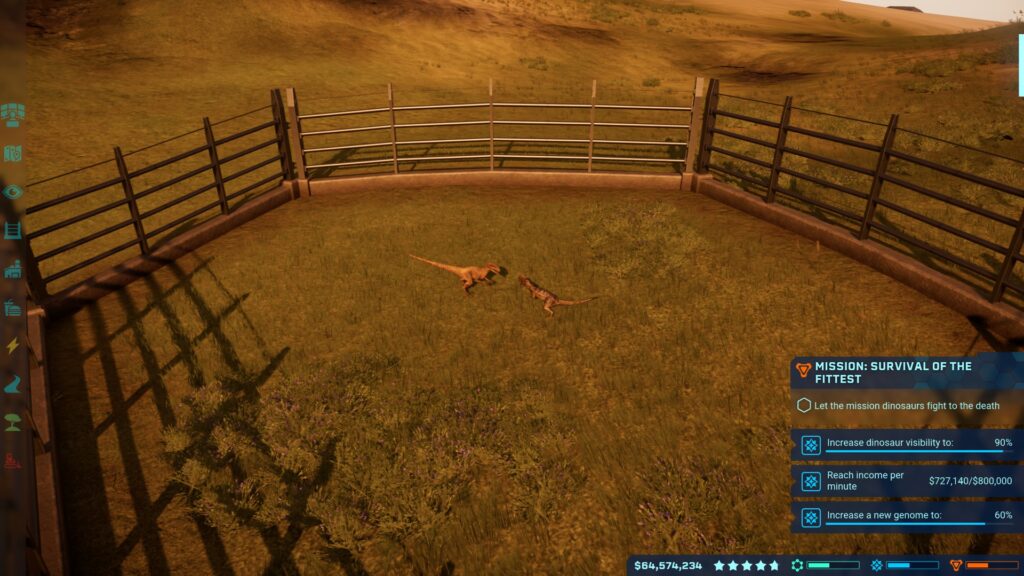
By far the biggest issue I have with the faction approach is the whole reputation system and how its implemented. Completing missions and contracts for one faction will raise your rep with them, allowing you to unlock rewards. Nothing inherently wrong there, but focusing on one faction will decrease your rep with the others.
The most extreme manifestation of lost rep is having park systems or buildings sabotaged. This is an incredibly game-y mechanic that stretches logic to its breaking point. You can get into situations where the Entertainment Division might open the gates to a T-Rex enclosure, allowing this apex predator to rampage its way across the park because they felt neglected and wanted more of your attention. Avoiding sabotage by rotating your faction contracts isn’t especially difficult, but still, it’s a completely out there mechanic that gets dumber the more you think about it.
Some of the missions are also just really tedious and annoying. The ones I hate the most are any mission where you have to keep an angry or agitated dinosaur contained for a set amount of time. You can’t tranq them because that stops the timer, and when they inevitably break out, you’ll have to recapture them to continue the mission. The only real solution is to do dumb stuff like this:
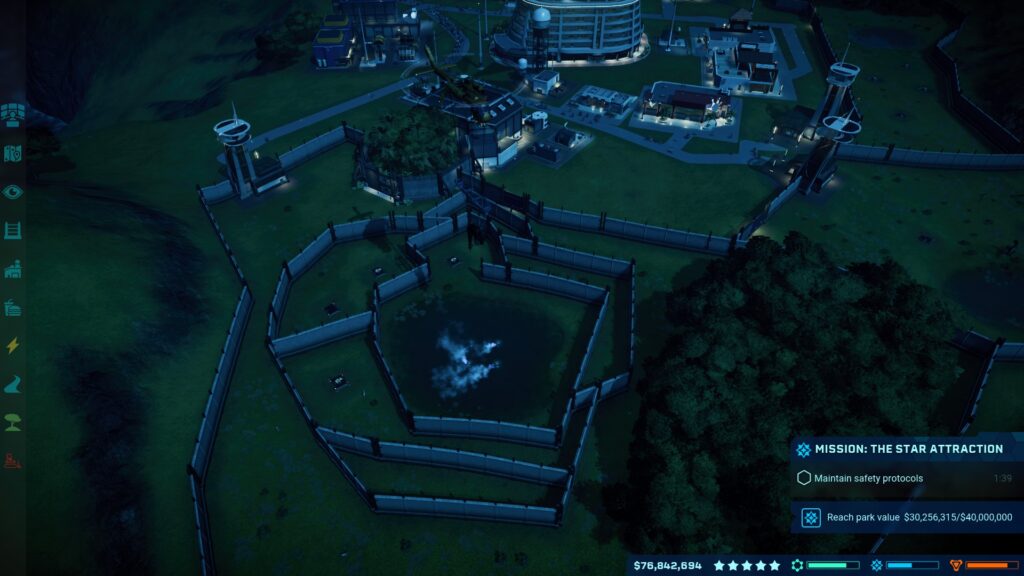
The real meat of the game is the actual construction of your own dinosaur theme park, and in this respect Jurassic World Evolution is a fairly mixed bag. Your primary attractions are the dinosaurs themselves. Building an enclosure is as easy as constructing a fence, adding or removing forests and water, throwing down some feeders, and building a Hammond Creations Lab to start hatching dinosaurs to release them into the enclosure for your guests to enjoy.
Each species of dinosaur has specific environmental preferences and population tolerances you’ll need to get right to keep them happy. Some dinosaurs might prefer to be alone, while others want large social groups and herds of other species. The general rules are that herbivores are fine with other herbivore species so long as the population and social group tolerances are met, small and large carnivores can be mixed together, and small carnivores can be housed with large or armored herbivores, though there are individual quirks with some species.
The tolerances can be a bit too specific at times, and I’ve encountered instances where the difference between a dinosaur being happy and uncomfortable came down to about five trees. Maybe that group of trees bullied them. The same can go with social groups and populations.
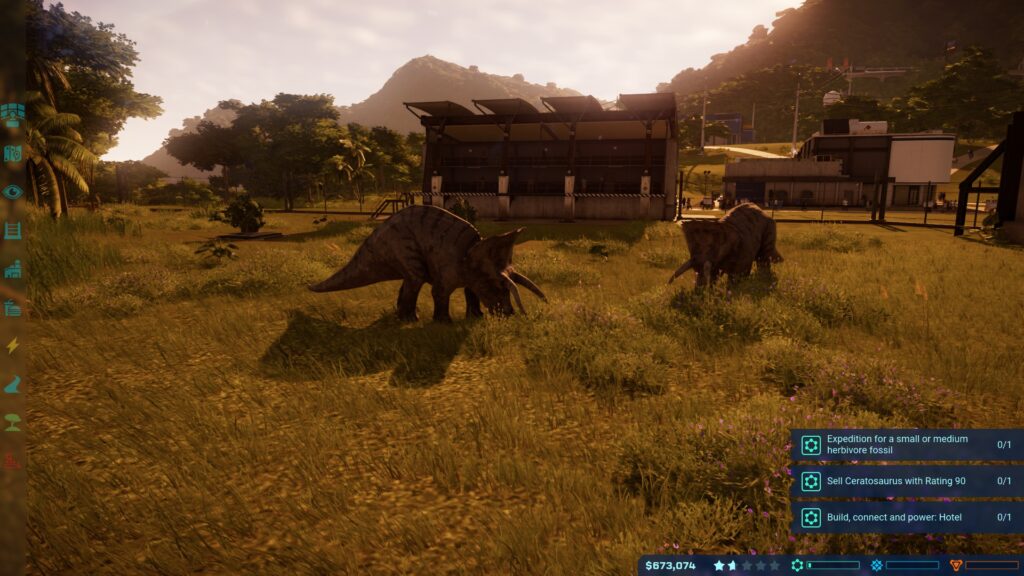
I encountered one particularly irritating disaster where I had exactly enough Stegosauruses in a pen to meet their minimum social group requirements when a storm hit and destroyed part of the fence. A few escaped, and I had to go about repairing the fences and tranquilizing the escapees. However, the Stegos’ remaining in the pin got really grumpy that their friends escaped, so they started attacking the fences as I tried to transport the original escapees back to their enclosure. Long story short, I eventually had to just tranq them all until they were all back in the pen because of their crippling separation anxiety.
In general though, once you get things down, dinosaur care really isn’t all that complicated. As long as you keep them fed, watered, and meet their environmental and social group tolerances, they’ll roam their enclosures doing their own thing without much trouble. Occasionally you may have to send some Rangers out to stop a epidemic, or maybe a storm will spook them and they’ll try to break out, but for the most part dinosaur care is fairly hands-off.
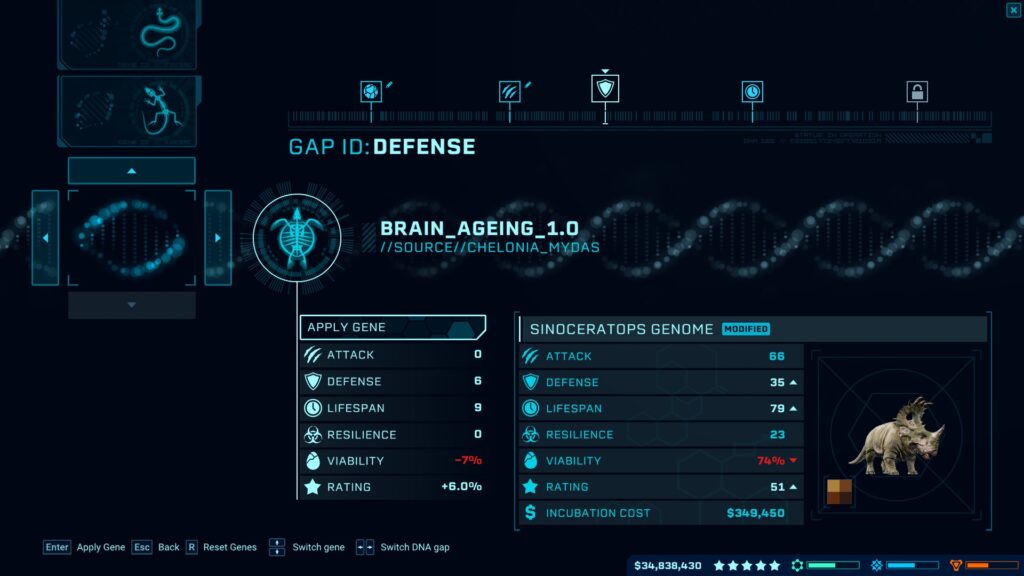
When you go to hatch a dinosaur, you are given the chance to apply a variety of genetic enhancements from several categories. These enhancements can be as straightforward as color palette swaps, to things like attack or defense upgrades, lifespan extenders, disease resistance, and more. You’ll unlock more of these modifications throughout the game. Generally you’ll probably be focusing on the ones that increase the dinosaur’s rating so it’ll draw in more customers.
Each modification you apply will decrease the hatchling’s viability, thus raising the chances that something might go wrong before the dinosaur has reached maturity and is ready to be released. You can offset this by completing the species’ genome, which involves sending teams to dig sites across the globe looking for fossils. This is also how you’ll gain access to more dinosaurs. Once they return with the fossils, you’ll need to extract the DNA, which will increase the completion of the genome based on the quality of the fossil.
Sometimes the dig teams will also find minerals or excess fossils that you can sell for a small injection of cash. Overall, the system is quite bland and grindy. The process of sending teams out and extracting DNA can take several minutes, though there are upgrades to speed things up, and you’ll probably need to send out a dozen or so expeditions to complete each genome. That’s assuming you get the fossils you need, too. It’s ultimately not a big deal since expeditions and DNA extraction is something you queue up in the background while doing other tasks, but it can get frustrating if a contract requires you to increase the genome of a specific species to a certain percentage.
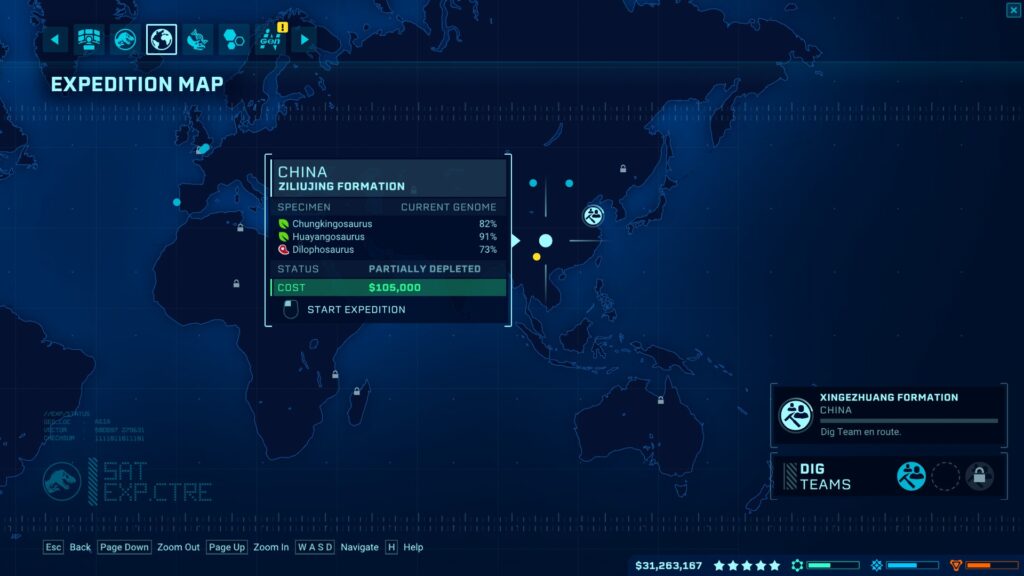
Dinosaurs aren’t the only living beings you’ll be caring for in your park, because no billion dollar zoo is complete without hordes of hungry consumers with deep pockets. Hotels, restaurants, gift shops, arcades, bars, and bowling alleys are but a few of the customer accommodations you’ll be building in your park. Unfortunately, the customer management aspect of Jurassic World Evolution is incredibly basic, and easily the weakest aspect of the entire game.
All customers need are food and drink, a hotel, shopping, fun, good viewing platforms to see your prehistoric beasts, and transportation. The tools for figuring out where these needs are in the highest demand consists solely of a tab that color codes buildings blue, yellow, orange, or red. Fixing this usually just involves constructing the right building nearby, but the customer demands are either broken or these are some of the most entitled tourists in the history of Earth. Here’s a picture of customers at a hotel demanding more transportation when they are across the street from a monorail station:
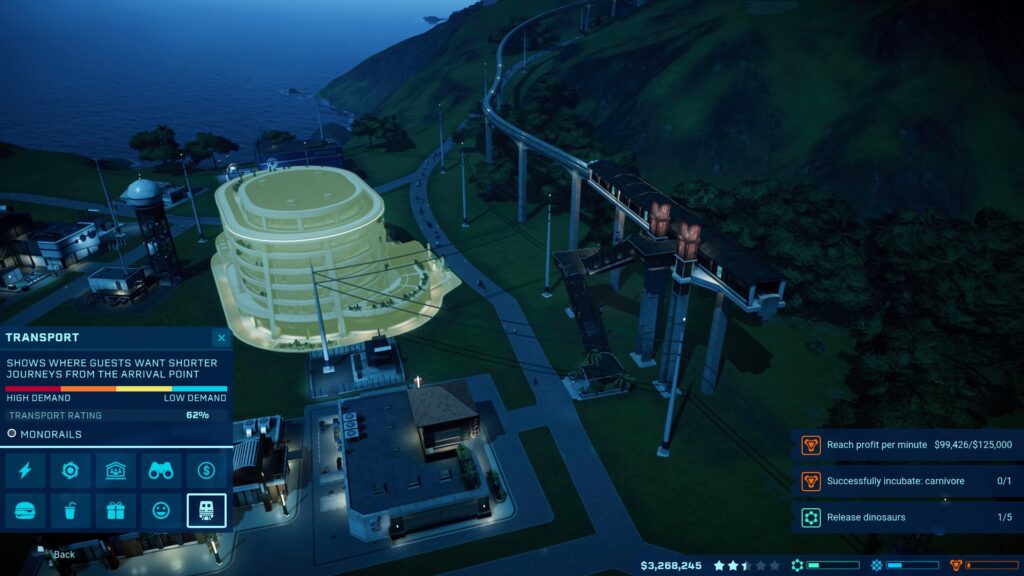
I guess they all want their own personal robot butlers to carry them over to the monorail station.
The “fun” rating is the most nebulous of all, and can result in some rather absurd situations. Dinosaurs, the very attraction these tourists are coming to see, have a separate rating system unrelated to fun or the other customer needs. This can cause situations where customers in the viewing platform of a Spinosaurus enclosure want you to build an arcade so they can play video games. Presumably this extinct apex predator that was resurrected through the miracles of modern super science is just really damn boring.
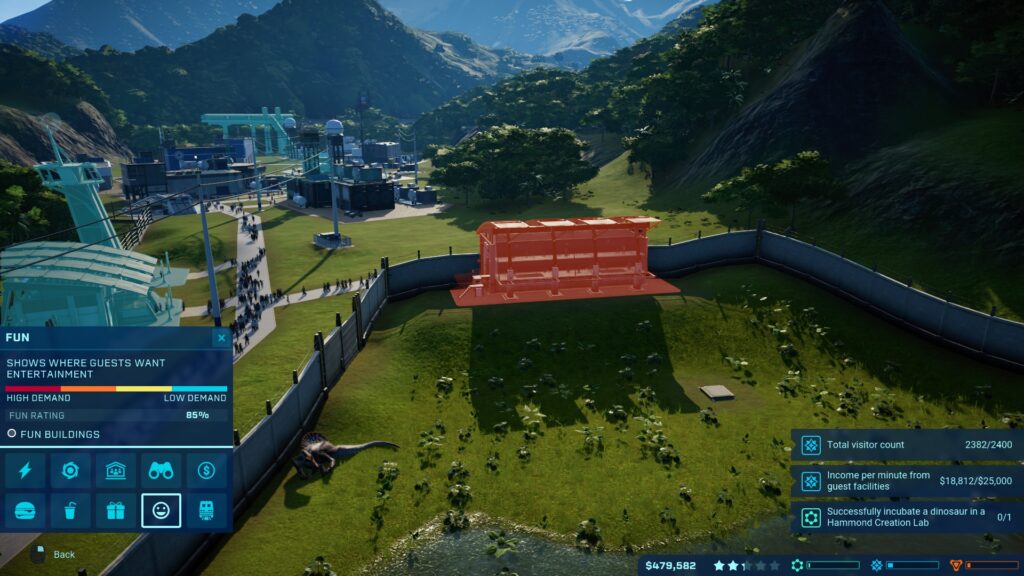
Your options for constructing your dream dinosaur park are also extremely limited. You have a handful of buildings that cater to each of the main customer needs and that’s basically it. You can’t decorate your park with tons of props or doodads to make it look pretty. The terrain sculpting tool is extremely anemic, and all you can really do is raise or lower terrain to a limited degree, flatten things out, and add some fairly generic trees and shrubs. You won’t be making advanced enclosures with diverse habitats and landscapes in Evolution.
Speaking of terrain, there are plenty of examples of the game just refusing to allow you to place a building because it decided half a pixel isn’t positioned just right.
Even the largest island is still quite small, another limiting factor in allowing you to build your dream Jurassic Park. Space will always be an issue, and you only have six maps to play with. No randomly generated maps, no way to really sculpt the terrain, no decorations to speak of. There just aren’t enough options here to really make the park your own. It’s all about placing prefabricated buildings connected by a few different pathway options.
The biggest highlight of the game are the dinosaurs themselves, which all look and sound great. Aside from fliers and aquatic animals, all the fan favorites from the franchise are here, and they look and sound just like their movie counterparts. There’s plenty of new dinosaurs too, and animal variety is definitely the area where the game excels, especially if you grab the deluxe version and the DLC packs. Frontier Developments put a lot of effort into making the animals look and sound great, even the new creatures that aren’t in the movies.
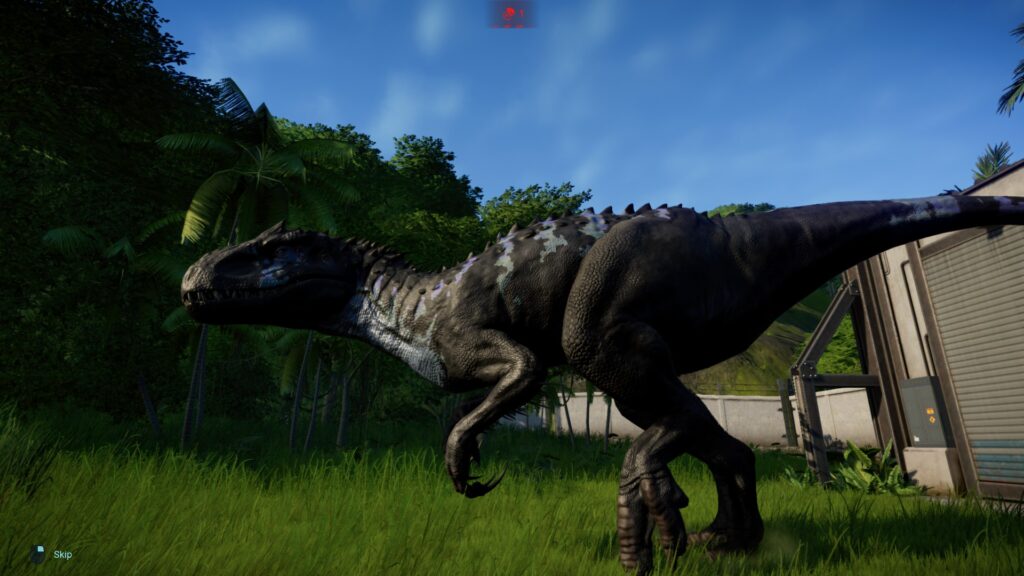
While the animations are good, you can tell that a lot of the dinosaurs are effectively re-skins of others. While each species has their quirks and preferences, dinosaur behavior is just as basic as the rest of the game. The dinosaurs don’t really interact between species aside from the obvious behaviors, like carnivores hunting their prey. The game received a patch that upgraded dinosaur behaviors late last year, adding things like sleeping, alphas, and basic herding instincts, but the behaviors are still lacking. The most obvious example of this is how dinosaur fights are always one on one duels, even if one of the animals involved is a pack hunter.
The AI for dinosaurs can also feel just as broken as the customer demands I mentioned earlier. I’ve had more than one occasion where a dinosaur nearly starved itself to death while standing right next to a feeder.
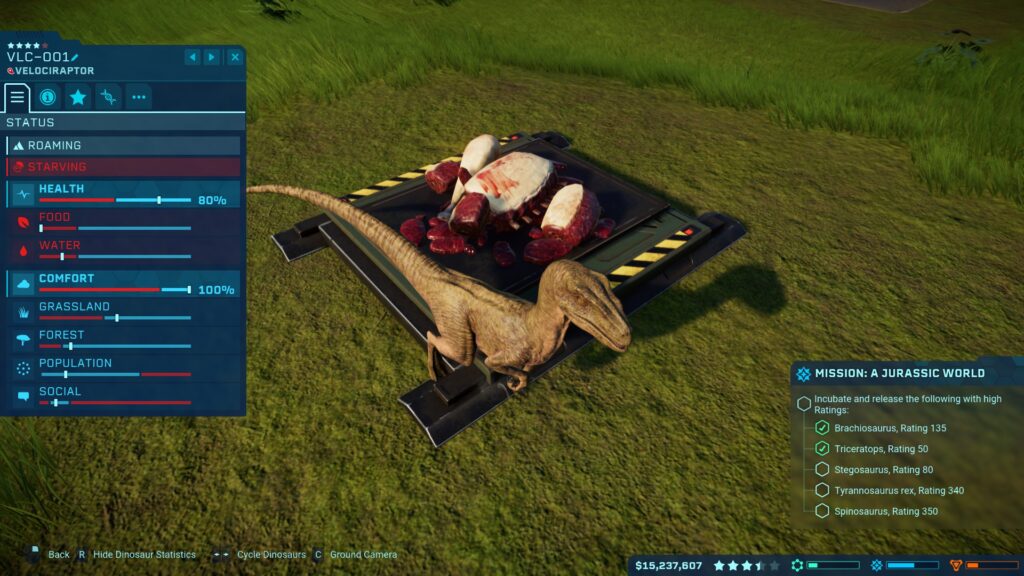
My final big complaint is that the game uses Denuvo. I never encountered any major issues I could have realistically blamed on this current DRM bugbear, but I know that for many PC gamers Denuvo is an instant black mark, so I’ll mention it anyway.
Despite how much I’ve spent complaining in this review, you’ll probably be surprised to hear that I don’t actually hate Jurassic World Evolution. Once you get past the slow early segments of an island and have a decent cash flow, the game can get rather enthralling, and I’ve spent several weekends awake in the wee hours of the morning hatching dinosaurs. Maybe its just my dinosaur-obsessed inner 12 year-old, but despite the game’s limitations, I’ve found myself excited to build new paddocks and populate them with my favorite species of dinosaurs.
Make no mistake, Jurassic World Evolution is a flawed and disappointing game, but there is still fun to be had in it. If you don’t mind the simplistic management mechanics, bizarre design decisions, and occasionally glitchy AI, then you’ll still find a decent enough dinosaur park tycoon game. I just can’t help but feel that it could have been so much better. There’s lots of potential here, with nice visuals, a clean UI, and great dinosaur variety. It’s just a shame that the core mechanics are so basic and limited, and unfortunately, the game’s flaws are so deeply ingrained within it that they probably can’t be fixed without dramatic rewriting of the game’s code.
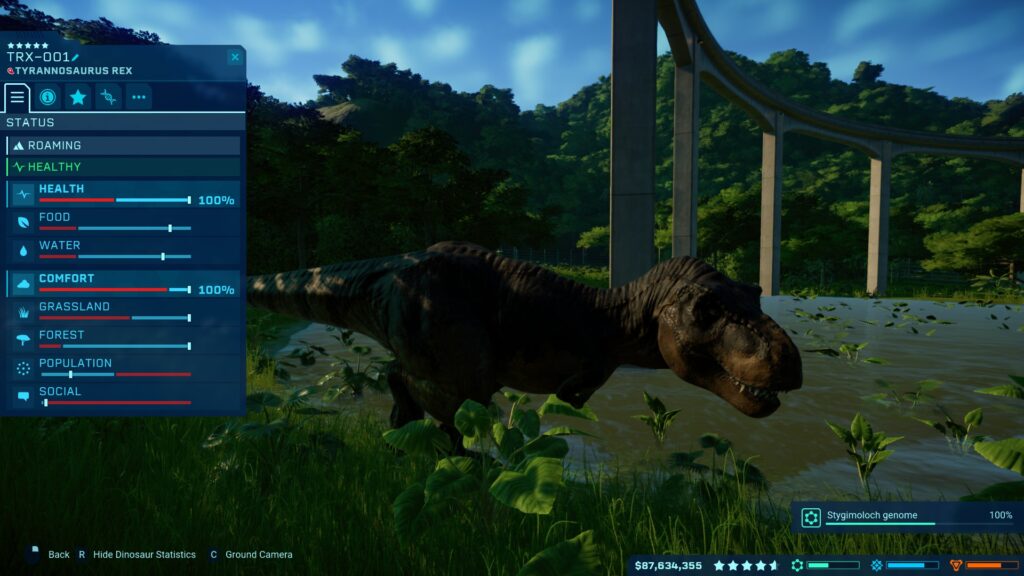
I bought the game when it was 60% off during a recent Steam sale and got 40 hours out of it. I didn’t even complete all the challenges or max the genomes of all the dinosaurs, so there’s plenty of actual content here. I just wish that it was much deeper and more complex than it currently is. If you like the idea of building your own dinosaur theme park and are a big fan of the franchise, then Jurassic World Evolution is still a decent buy during a sale. Just be prepared to battle with some wonky mechanics and disappointingly simple management options.
Jurassic World Evolution was reviewed on PC using a review copy purchased by Niche Gamer. You can find additional information about Niche Gamer’s reviews/ethics policy here.